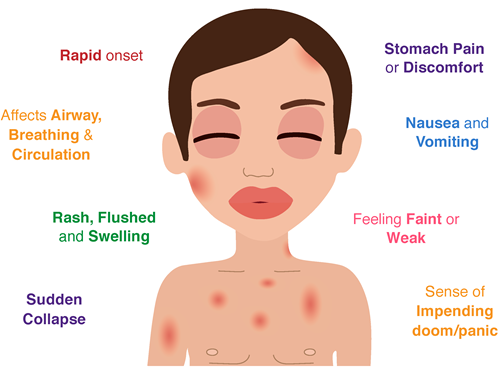Nursing Paper Example on Anaphylaxis
Nursing Paper Example on Anaphylaxis
Anaphylaxis is a severe, potentially life-threatening systemic allergic reaction that can occur within minutes of exposure to an allergen. It is characterized by rapid onset and multisystem involvement, including respiratory, cardiovascular, and cutaneous symptoms. Immediate recognition and treatment are crucial to prevent fatal outcomes. While the condition is rare, its potential severity warrants public awareness and medical preparedness.

Causes of Anaphylaxis
Anaphylaxis occurs due to the activation of immune mechanisms triggered by allergens. The most common causes include:
Food allergens: Peanuts, tree nuts, shellfish, milk, and eggs are frequent triggers, particularly in children.
Medications: Antibiotics like penicillin and nonsteroidal anti-inflammatory drugs are common causes in adults.
Insect stings: Venom from bees, wasps, and hornets can induce anaphylaxis.
Latex exposure: Medical products containing latex are a risk for sensitized individuals.
Exercise-induced anaphylaxis: Triggered by physical activity, often in conjunction with certain foods or medications.
Other triggers include radiocontrast agents, biological therapies, and unidentified allergens in idiopathic anaphylaxis.
Signs and Symptoms
Anaphylaxis presents with symptoms that develop rapidly and affect multiple organ systems.
Respiratory symptoms: Wheezing, shortness of breath, throat tightness, or stridor due to airway edema.
Cardiovascular symptoms: Hypotension, dizziness, syncope, or tachycardia resulting from vascular leakage and reduced cardiac output.
Gastrointestinal symptoms: Abdominal pain, nausea, vomiting, or diarrhea.
Cutaneous symptoms: Urticaria (hives), angioedema, or flushing are often the first manifestations.
Neurological symptoms: Anxiety, confusion, or a sense of impending doom, which may precede loss of consciousness.
Without timely intervention, progression to respiratory arrest, circulatory collapse, or death is possible.
Etiology
Anaphylaxis results from an exaggerated immune response, usually mediated by immunoglobulin E (IgE) antibodies.
IgE-mediated reactions: Initial allergen exposure sensitizes immune cells, leading to IgE production. Upon re-exposure, allergens cross-link IgE on mast cells and basophils, causing degranulation and the release of mediators such as histamine.
Non-IgE-mediated reactions: Direct activation of mast cells and basophils occurs without IgE, as seen with radiocontrast agents or opioids.
The cascade of immune activation leads to widespread vasodilation, increased vascular permeability, and smooth muscle contraction, culminating in multisystem involvement.
Pathophysiology
The pathophysiological changes in anaphylaxis involve systemic mediator release that affects multiple systems:
Mediators of anaphylaxis: Histamine, leukotrienes, prostaglandins, and cytokines contribute to the symptoms.
Vasodilation and increased vascular permeability: These changes result in hypotension and angioedema.
Airway constriction: Smooth muscle contraction causes bronchospasm, leading to respiratory distress.
Cardiovascular compromise: Hypovolemia and myocardial depression can cause shock and cardiac arrest.
These changes occur rapidly, underscoring the need for prompt intervention.
DSM-5 Diagnosis
Anaphylaxis is not a psychiatric disorder; hence, it is not classified in the DSM-5. However, individuals with recurrent anaphylaxis may develop anxiety disorders, including post-traumatic stress disorder, due to the fear of another episode. Psychological support should be provided as part of the management.
Diagnosis
Diagnosing anaphylaxis is clinical, requiring a detailed history and physical examination. Key diagnostic criteria include:
Rapid onset of symptoms: Symptoms involving skin, respiratory, or cardiovascular systems within minutes to hours after allergen exposure.
Laboratory tests: Elevated serum tryptase levels confirm mast cell activation but are not essential for diagnosis.
Rule out differential diagnoses: Conditions like vasovagal syncope, asthma, or myocardial infarction may mimic anaphylaxis and need exclusion.
Prompt recognition ensures timely management.
Treatment Regimens
Management of anaphylaxis is a medical emergency requiring immediate intervention:
- First-line treatment:
Epinephrine injection: Administer intramuscular epinephrine (0.3–0.5 mg in adults) into the mid-anterolateral thigh. Repeat every 5–15 minutes as needed.
- Supportive care:
Oxygen therapy: High-flow oxygen for hypoxemia or airway compromise.
Intravenous fluids: Rapid infusion of isotonic fluids to correct hypotension.
Airway management: Intubation or tracheotomy if severe airway obstruction occurs.
- Adjunctive therapies:
Antihistamines: H1 and H2 blockers alleviate cutaneous and gastrointestinal symptoms.
Corticosteroids: Used to prevent biphasic reactions, though their immediate efficacy is limited.
- Long-term management:
Avoidance of triggers: Identify allergens and educate patients on avoidance strategies.
Allergy immunotherapy: Desensitization may be appropriate for certain allergens.
Epinephrine auto-injectors: Prescribe and educate patients on proper use.
Patient Education
Education plays a critical role in preventing and managing anaphylaxis.
Allergen identification: Advise patients to undergo allergy testing to identify triggers.
Emergency preparedness: Teach patients to recognize early symptoms and administer epinephrine promptly.
Lifestyle adjustments: Encourage carrying an epinephrine auto-injector and wearing medical identification jewelry.
Psychological support: Address fears or anxiety associated with recurrent episodes.
Empowering patients with knowledge enhances safety and quality of life.
Additional Considerations
Biphasic anaphylaxis: Recurrence of symptoms 1–72 hours after the initial episode, even without re-exposure to the allergen, necessitates prolonged observation.
Prognosis: With prompt treatment, anaphylaxis is reversible. However, delayed administration of epinephrine increases the risk of fatality.
Conclusion
Anaphylaxis is a rapidly progressive, life-threatening condition that demands immediate medical attention. While its triggers and manifestations vary, the cornerstone of management remains prompt epinephrine administration and supportive care. Through proper diagnosis, treatment, and patient education, severe outcomes can be prevented. Ongoing research into immunological mechanisms and novel therapies promises to improve the future management of anaphylaxis.
References
Lieberman, P., et al. (2015). Anaphylaxis – a practice parameter update 2015. Journal of Allergy and Clinical Immunology, 115(3), 636-645. https://doi.org/10.1016/j.jaci.2015.07.019
Muraro, A., et al. (2014). Anaphylaxis: Guidelines from the European Academy of Allergy and Clinical Immunology. Allergy, 69(8), 1026-1045. https://doi.org/10.1111/all.12437
Simons, F. E. R. (2021). Anaphylaxis: Rapid recognition and treatment. New England Journal of Medicine, 372(4), 358-368. https://doi.org/10.1056/NEJMra1409887
Sicherer, S. H., & Leung, D. Y. M. (2017). Advances in allergic diseases, mechanisms, and treatment. Journal of Allergy and Clinical Immunology, 140(5), 1180-1185. https://doi.org/10.1016/j.jaci.2017.09.025



